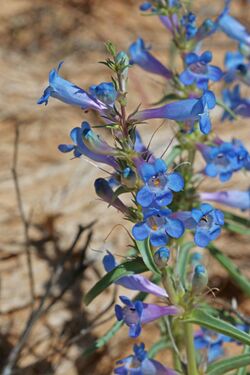Biology:Penstemon angustifolius
| Penstemon angustifolius | |
|---|---|

| |
| Scientific classification | |
| Kingdom: | Plantae |
| Clade: | Tracheophytes |
| Clade: | Angiosperms |
| Clade: | Eudicots |
| Clade: | Asterids |
| Order: | Lamiales |
| Family: | Plantaginaceae |
| Genus: | Penstemon |
| Species: | P. angustifolius
|
| Binomial name | |
| Penstemon angustifolius | |
Penstemon angustifolius is a perennial subshrub belonging to the plantain family. This species is 1 out of roughly 180 species of Penstemon.[1][2] This species is also known as broadbeard and beardtongue.[1] This subshrub is native to central United States and can be noticed by its brightly colored flowers.[1]
Description
Penstemon angustifolius can grow between 4 to 24 inches tall.[3] Their basal leaves range from 2–9.5 cm in length.[3] This species stems are a thick, waxy, gray-green. The flowers can be a range of colors, from pink and blue to lavender which bloom from April to June.[3]
Distribution and habitat
This species is found in the west-central United States extending from Montana and North Dakota to Arizona, New Mexico, and Kansas.[4] They can be found in the Great Plains and the Rocky Mountains. They are drought tolerate and live in sandy soil with good drainage.[4][3] These plants grow near each other in groups that can be found at elevations of 1200–2200 m.[3]
Ecology
This plant is useful in preventing wind erosion in its native environment.[3] Deer and insects are known to eat parts of the penstemon plant.[4] Native bees especially enjoy this plant[3] and the seeds are used by birds, rodents, ants and bees.[3] Penstemon weevils are an observed herbivore of this plant.[5]
Culture and use
Penstemon angustifolius have been cultivated as early as the 1800s.[6] Native Americans have been recorded to use the plant roots medicinally.[6] Additionally the pigment from the petals has been used to paint moccasins by the Lokota.[6] This plant can be used in landscaping and as a garden plant in xeriscaping situations.[7]
References
- ↑ Jump up to: 1.0 1.1 1.2 "USDA Plants Database". https://plants.usda.gov/home/plantProfile?symbol=PEAN4.
- ↑ "Western USA wildflowers: narrowleaf beardtongue, Penstemon Angustifolius". https://www.americansouthwest.net/plants/wildflowers/penstemon-angustifolius.html.
- ↑ Jump up to: 3.0 3.1 3.2 3.3 3.4 3.5 3.6 3.7 "USDA Plants Database". https://plants.usda.gov/home/plantProfile?symbol=PEAN4.
- ↑ Jump up to: 4.0 4.1 4.2 "Southwest Colorado Wildflowers, Penstemon angustifolius". https://www.swcoloradowildflowers.com/Blue%20Purple%20Enlarged%20Photo%20Pages/penstemon%20angustifolius.htm.
- ↑ Ogle, D., Peterson, S., St. John, L. 2013. Plant Guide for Palmer’s penstemon (Penstemon palmeri). USDA-Natural Resources Conservation Service, Plant Materials Center. Aberdeen, Idaho 83210.
- ↑ Jump up to: 6.0 6.1 6.2 Stevens, Mikel (2020) (in English). The Heart of Penstemon Country: A Natural History of Penstemons in the Utah Region. Sweetgrass Books. pp. 70-73. ISBN 978-1591522614.
- ↑ Penstemon angustifolius. USDA NRCS Plant Fact Sheet.
Wikidata ☰ Q7164830 entry
 |



